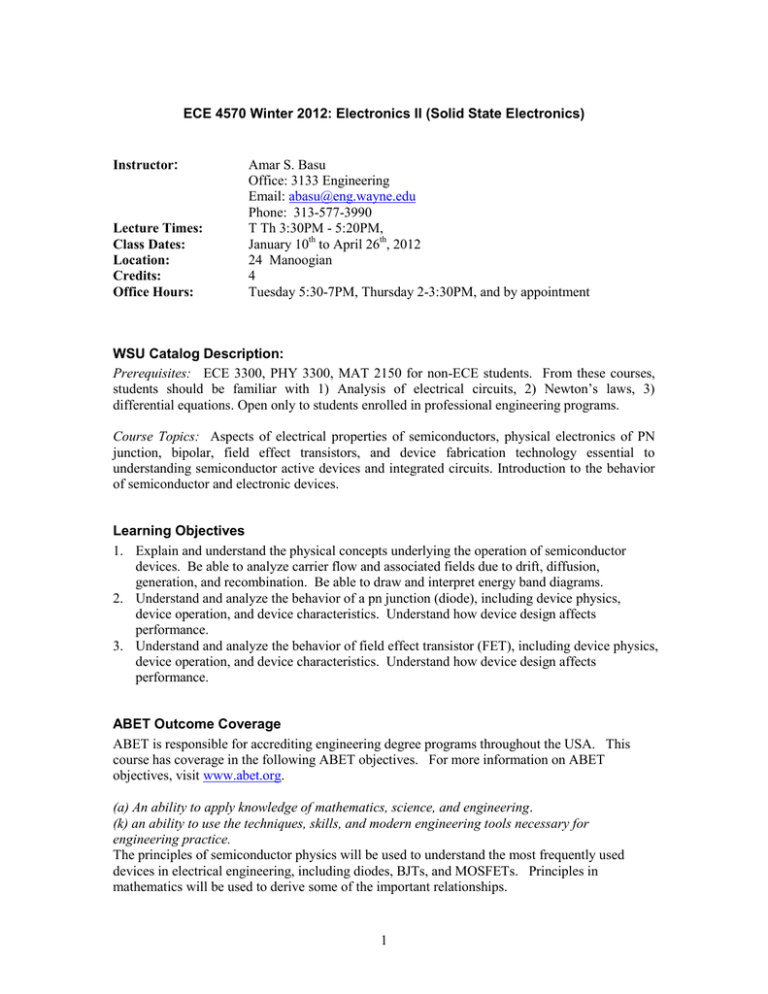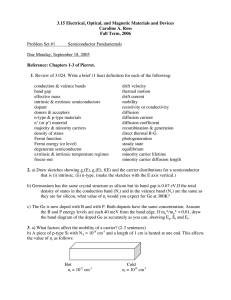ECE 5550 Solid State Electronics
advertisement

ECE 4570 Winter 2012: Electronics II (Solid State Electronics) Instructor: Lecture Times: Class Dates: Location: Credits: Office Hours: Amar S. Basu Office: 3133 Engineering Email: abasu@eng.wayne.edu Phone: 313-577-3990 T Th 3:30PM - 5:20PM, January 10th to April 26th, 2012 24 Manoogian 4 Tuesday 5:30-7PM, Thursday 2-3:30PM, and by appointment WSU Catalog Description: Prerequisites: ECE 3300, PHY 3300, MAT 2150 for non-ECE students. From these courses, students should be familiar with 1) Analysis of electrical circuits, 2) Newton’s laws, 3) differential equations. Open only to students enrolled in professional engineering programs. Course Topics: Aspects of electrical properties of semiconductors, physical electronics of PN junction, bipolar, field effect transistors, and device fabrication technology essential to understanding semiconductor active devices and integrated circuits. Introduction to the behavior of semiconductor and electronic devices. Learning Objectives 1. Explain and understand the physical concepts underlying the operation of semiconductor devices. Be able to analyze carrier flow and associated fields due to drift, diffusion, generation, and recombination. Be able to draw and interpret energy band diagrams. 2. Understand and analyze the behavior of a pn junction (diode), including device physics, device operation, and device characteristics. Understand how device design affects performance. 3. Understand and analyze the behavior of field effect transistor (FET), including device physics, device operation, and device characteristics. Understand how device design affects performance. ABET Outcome Coverage ABET is responsible for accrediting engineering degree programs throughout the USA. This course has coverage in the following ABET objectives. For more information on ABET objectives, visit www.abet.org. (a) An ability to apply knowledge of mathematics, science, and engineering. (k) an ability to use the techniques, skills, and modern engineering tools necessary for engineering practice. The principles of semiconductor physics will be used to understand the most frequently used devices in electrical engineering, including diodes, BJTs, and MOSFETs. Principles in mathematics will be used to derive some of the important relationships. 1 (c) An ability to design a system, component, or process to meet desired needs within realistic constraints such as economic, environmental, social, political, ethical, health and safety, manufacturability, and sustainability For the semiconductor devices, we will discuss design criteria versus performance criteria, as well as tradeoffs device designers must consider. (g) an ability communicate effectively (j) a knowledge of contemporary issues (h) the broad education necessary to understand the impact of engineering solutions in a global, economic, environmental, and societal context (i) a recognition of the need for, and an ability to engage in life-long learning During each class, one student will be chosen to give a short presentation on how the course content relates to contemporary issues. This could be electronics technology, modern research topics in academia/industry, applications of semiconductor devices. This will help students in building communication skills in an informal setting, build knowledge of contemporary issues, and appreciate the importance of electronics in a larger context. Textbook and Other resources: Course textbook: B. Streetman, S.K. Banerjee, Solid State Electronic Devices, 6th Ed, New Jersey: Prentice Hall 2006. http://wps.prenhall.com/esm_streetman_solidstateelecdev_6/ If you are confused about a topic in our textbook or my lecture notes, try to look up additional references in the list below. Whether you end up in industry or grad school, it is very important to learn how to independently become an expert in a new subject. Suggested reading lists at the end of each chapter Popular textbooks in semiconductor physics o Singh, Semiconductor Devices o Pierret, Semiconductor Device Fundamentals o S.M. Sze, Physics of Semiconductor Devices MIT Open Courseware (http://ocw.mit.edu/OcwWeb/Electrical-Engineering-and-ComputerScience/6-012Fall-2005/LectureNotes/index.htm) Online sources such as Wikipedia (http://www.wikipedia.org). Be careful with online sources because their accuracy cannot be verified. (And of course, feel free to contact me or come to office hours) Course Modules (Tentative) 0. Introduction/Motivation – why study semiconductor device physics? 1. Crystal structures, atoms, and electronic properties (Ch 1-2) a. Crystal structures b. Fabrication c. Atomic structure, the Bohr model and Schrodinger wave equation d. Structure of semiconductors, conductors, and insulators. How structure relates to material properties 2. Energy bands and carriers in semiconductors (Ch. 3) a. Mobile vs. static carriers. Electrons and holes 2 3. 4. 5. 6. b. Intrinsic semiconductors: carrier concentrations, density of states, conductivity c. Energy band Diagrams: conduction and valence band, Fermi level d. Doped semiconductors: acceptors and donors, how they alter the physical structure and the energy band, effect on carrier concentration e. Carrier transport mechanisms: Drift, Diffusion f. Carrier generation and recombination PN Junction diode (Ch. 5) a. Physical concepts: Depletion layer, mobile and static charges, drift and diffusion, coulomb’s law, diffusion/electrical balance b. Energy band interpretation: Band bending, junction potential, drift and diffusion c. Physical characteristics: depletion width, depletion and diffusion capacitance d. Electrical characteristics: IV characteristics, forward and reverse bias, reverse breakdown, small signal model Bipolar Junction Transistor (Ch. 7) a. Physical concepts: Emitter/Base/Collector orientation and doping, carrier ‘sweeping’, base recombination b. Energy band interpretation: band bending in a three terminal device, potential wells, drift and diffusion c. Physical characteristics: Capacitance, depletion width, base width d. Electrical characteristics: Gain, Injection efficiency, collector efficiency, emitter efficiency, Base transport factor, IV Characteristics, forward active/reverse active/cutoff/saturation, small signal model MOSFETs (Ch. 6) a. Physical concepts: Inversion channels, channel pinchoff b. Physical characteristics: gate thickness, substrate doping, work function c. Electrical characteristics: IV characteristics, cutoff/triode/saturation regions of operation, Early voltage, small signal model (Other concepts addressed, time permitting) a. Fabrication and Process Technology a. Basic introduction to process technology: Photolithography, etching, oxidation, diffusion b. BJT fabrication c. MOSFET fabrication b. Optoelectronic devices a. Photodiodes, including solar cells and CCDs b. Light emitting diodes (LEDs) c. Lasers Attendance Policy: Students are required to attend class, and attendance will be taken if necessary. 3 absences are allowed for documented personal/medical reasons. Please email me in advance if you know you will miss a class. However, on the exam dates listed in the course calendar, attendance is absolutely mandatory. No makeup exams will be given, so please email me within the first week of classes if you have a conflict on these dates. Grading Policy: 3 20% Quizzes. These will be assigned approximately once per week, and will be entirely based on the homework assignments (Homeworks are not collected) 45% Two midterms (each 22.5%) 30% Final exam 5% reserved for attendance, and pop quizzes if necessary Grading scale (subject to change) A 94-100 A90-93 B+ 85-89 B 80-84 B75-79 C+ 70-74 C 65-69 C60-64 D 50-59 E 0-49 Cheating Policy and Penalty for Cheating: Cheating is defined by the University as “intentionally using or attempting to use, or intentionally providing or attempting to provide, unauthorized materials, information, or assistance in any academic exercise.” This includes any group efforts on assignments or exams unless specifically approved by the professor for that assignment/exam. Evidence of fabrication or plagiarism, as defined by the University in its brochure Academic Integrity, will also result in downgrading for the course. Students who cheat on any assignment or during any examination will be assigned a failing grade for the course. Blackboard: We will use the WSU blackboard website extensively in this course. Please log on to http://blackboard.wayne.edu and make sure you have access to ECE 4570 course website. Our blackboard site will be used for the following: Lecture slides, homeworks, and course information will be posted. I will plan to upload lecture slides at least 2 hours before lecture begins. Please print them out and bring them to class with you. Lecture and homework related questions Discussion boards in blackboard will be used to post answers to questions related to the lectures and homework. Please post your questions to the appropriate blackboard discussion group. I will be checking them periodically and will post answers as soon as possible Anonymous feedback: There is a blackboard discussion group specifically for anonymous course feedback. Please be sure to check the ‘anonymous’ box and feel free to give your honest feedback and constructive criticism about how the course can be improved. Grades: You will be able to access your current grades at any time. Urgent notices: Those who have registered with the WSU emergency alert system can receive text messages on your cell phone. I will use the broadcast system in case of last minute class cancellations or other urgent notices. 4 Feedback: I as well as the ECE department value your feedback in how we can make this course better and better serve your needs. The standard WSU course evaluations will also be given at the end of the term. We may have midterm teaching evaluations of the course sometime in the middle of the semester. Anonymous feedback can be posted anytime through blackboard. If you have any personal issues with the course, please come to office hours or setup an appointment to speak with me individually 5


